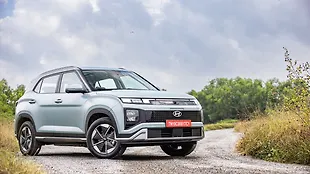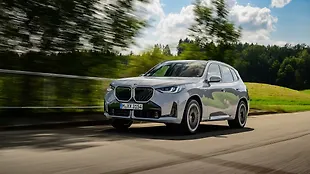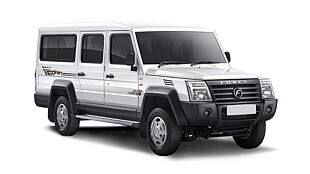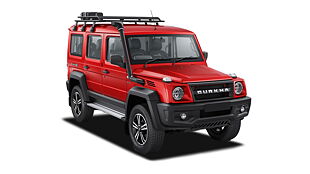Why would I buy it?
- Off-road capability
- Exclusivity makes it grab attention
- Added improvements over the previous generation
Why would I avoid it?
- Little rough around the edges
- Sales and aftersales service needs improvement
Verdict

Some cars are like urban legends. They are much talked about but no one has ever seen them for real. Force Gurkha is one such capable off-roader which we never saw on the roads, ever! But at the 2020 Auto Expo, the orange brute at Force stand grabbed some serious attention for its comprehensive update. These updates in the new-gen Gurkha transform its on-road dynamics, making it a lifestyle SUV that will be equally at home scaling a mountain as it will be while climbing an office parking ramp. Gone are its utilitarian roots which are replaced with higher levels of safety, refinement, and livability.

It still can conquer tough terrains, wade rivers, crawl rocks, and trudge through slush without breaking a sweat. Retaining this very 4x4 charm, the update to the new-gen Gurkha still has a scope of ironing out a few crumples here and slight creases there. But we hope to see the new Gurkha more often on the streets as it’s now very much capable of taking you to work on weekdays and across the wilderness on weekends.
Engine and Performance
6.5 / 10

In its BS6 avatar now, the long-serving Mercedes-sourced 2.6-litre turbo-diesel runs much smoother with lesser vibrations and is slightly less audible. Few rattles are felt on the steering and seats – and the rearview mirror never stops jiggling – but it’s much improved. Part of this improvement comes from better insulation in and around the engine bay along with a newer chassis that’s also modular (to accommodate a longer wheelbase for a five-door model). It’s paired with a five-speed manual gearbox with a proper low-range gearbox and individually locking front and rear differentials.

Since the new Gurkha has been updated for on-road dynamics, let’s talk about that first. For operation, there’s a long clutch travel, the gearlever is vague and notchy, and the brake pedal and accelerator are too close to comfort. Crank up the motor and it settles into a refined whirr than a typical clatter. For a 4x4 SUV, 90bhp might not sound much, but the 250Nm of torque supply is available from 1,400rpm and that’s plenty enough to keep pace. It’s not a rev-happy motor though. Anything past 2,000rpm feels restrained and it runs out of ammo way before the 3,500rpm mark. We weren’t able to gauge the highway manners of the Gurkha, and that’s something to look forward to in our comprehensive road test.

As for the transmission, the gearlever sticks out towards the driver like the good-old commercial diesel vehicles sans the ruggedness. Its rubbery shifts don’t take a lot of effort to work the gearbox, thus saving the driver from fatigue after long hours. Even the loads of torque supply helps in reducing the need for constant gearshifts. Despite the long travel, the clutch is light and doesn’t have that odd spring-back action which is a huge relief. But the bummer is that a dead pedal is given a miss.

As the road starts disappearing and becomes non-existent, the Gurkha comes into its own. Be it slush and rock crawling, steep uphill climb over slippery ruts, splash through deep waters, mud plunging, trudging through grasslands or proper overlanding – the Gurkha can do it all. It might even do most of the stuff in the 2H setting effortlessly. And only in the extreme terrains do the mechanically-engaging 4H or 4L need to be engaged. But do that, and the Gurkha will take care of everything. The low-range gear ratios help the 4x4 not stick even in the trickiest of the situation. And even a novice like me could feel like a hero traipsing through punishing terrains as if it’s a walk in the park. What’s more, get a wheel or two in the air and the locking differential will pull through like it’s all in the day’s work for the Gurkha.

To throw in some facts and figures, the Gurkha has a water wading capacity of up to 700mm, ground clearance of 205mm, around 35degree off-road angles, coil spring suspension on all four corners, snorkel air-intake, and metal skid plates both fore and aft. Its suspensions might not have huge articulation but do have some serious travel. So even at demanding angles, some part of the large profile tyre was touching the ground. Hence, we never got a real chance to engage the diff-locks and see it in action. In a typical 4x4 style, fighting the steering and proper throttle input will get the Gurkha out of any trouble, despite having a greenhorn like me at the helm.
Ride and Handling
7 / 10

One of the aspects that should have been improved with the newer chassis and enhanced body shell is ride quality. It’s a ladder-on-frame SUV and so the ride is expectedly well-absorbent. But it’s jittery too and spending long hours on broken road surfaces would send the passengers in dizzy. On smoother surfaces, the ride is improved significantly and cross-country travel over well-paved tarmac should be fun in the new Gurkha. Moreover, there’s no need to slow down over the occasional crevasse, broken patches, and large potholes. On the flipside, suddenly chucking the Gurkha is unnerving.

There’s loads of body roll and at higher speeds, the tyres would also lose grip unsettling the 4x4 even more. Under heaving braking, there’s nose dip too. And even the side-to-side and up-and-down movements at higher speeds are considerably high – a trade-off for 4x4 capability and it certainly is liveable.

As for the steering, there’s a huge dead-zone off-centre. Past that, the steering is heavy and there’s little feedback from the tyres – especially driving on the roads. Quick three-point turns in the Gurkha could be considered an extreme sport and would be a favourite amongst gym buffs. Thankfully, the claimed turning radius is just 5.65m. But, as mentioned earlier, the steering plays a vital role when off-roading in extreme conditions and there’s nothing we’d change in the Gurkha’s steering except that it was less vague for on-road driving. Lastly, the brake feel could be improved as it felt vague at times with unnecessarily long travel before the real action happens. But it can stop the relatively heavy Gurkha with confidence.

Interior Space and Quality
5 / 10

Taking a look at the older Gurkha and climbing in the new one, one could notice the improvements inculcated with the new generation. First-up, the quality of plastic used all-around has seen some improvement, albeit it is still more on a rugged side compared to your modern-day pseudo SUVs. A welcome addition is a seven-inch touchscreen sourced from Kenwood. And instead of the opposite facing bench, the new Gurkha is a four-seater with individual bucket/captain seats.

Out goes the sliding window for the rear passengers and in its place is a single-piece glass pane on either side. Interestingly, accessibility for the rear two passengers is through the rear door only by walking between the two seats. It’s not graceful, but works.

The practicality of the newer cabin is up too. Apart from two cup holders, the centre console and dashboard have a few nooks and recesses to store your knick-knacks. The door pad has space for stowing few papers too. The air-con controls are easy to reach. The inclusion of a 12-volt supply and USB ports make the Gurkha slightly more modern. The steering wheel is large and simple with no gimmicks. Behind it, there’s an old-school analogue dial with a small digital screen reading out bare minimum details. Another new and modern addition is a TPMS reader sitting atop the right-most corner of the dashboard.

We liked the new screen’s touch response and speed, but its interface leaves much to be desired. On the upside, it has Android Auto and Apple CarPlay connectivity with the four speakers not sounding half as bad either.
The upright dashboard lends a commanding view all around. Even the massive rear glass helps with the visibility all around the vehicle, especially on an off-road trail. We liked the improvement in the seats over the previous generation. It’s got cloth upholstery which should be easy to clean after off-road expeditions. All four seats offer good support. But the driver’s seat is not adjustable for height and the rear seats don’t get a fore-and-aft adjustment, just the recline. So, the legroom and headroom for rear passengers are fixed, which is decent for my frame (I am 5’5). Spending long hours in any of the four seats should be comfortable too.

But the hard roofline is a reason to complain. While getting off the seat suddenly, smacking head on the roof will surely hurt. And the rear passengers have to make do with lap belts. The armrest for the rear two seats is straight out of a Force bus seat. There’s ample space behind the second set of seats, and you can also opt for a roof-mounted carrier with a dedicated jerry can. Overlanding is one of the important aspects of the Gurkha’s personality after all.
Features and Equipment
5 / 10

Compared to the utilitarian previous-gen, the new 2021 Gurkha has a decently long feature list. It includes new circular LED headlamps with integrated LED DRLs, a grille with the Gurkha lettering, front fender-mounted turn indicators, a snorkel, cornering fog lights, and new vertically-positioned tail lights. The rear door-mounted spare wheel and a rear tow-hook is a nice touch while there are loads of customisation and personalisation potential in the new Gurkha.

Some accessories offered include new 16-inch steel wheels, a roof rack, bull bar on the windscreen, jerry can, rear-mounted ladder, and five flashy colours – red, green, white, orange, and grey. Safety features include dual airbags, ABS with EBD, rear parking sensors, TPMS, a speed alert system, seat-belt reminder, and a speed-sensing auto door lock function.
Conclusion

The new Force Gurkha has indeed come a long way. It’s not one dimensional anymore. This means the new Gurkha is now capable of taking you to work through the week, while also carrying your friends and family to picnic on a mountain top, in the jungle, or beside a far lakeside on the weekends. With an increase in demand for vehicles with intense off-road credibility, buyers looking for a 4x4 with all the essential hardware but not so eager on spending a bomb for Defender or Wrangler now have one more option to look at.

But Force Motors first needs to get the pricing right for the updated Gurkha to get people talking. They need to introduce an exciting introductory price (perhaps undercut Thar’s pricing first) to create a buzz. Then back it up with proper sales and aftersales network to keep the momentum rolling.

Its only nemesis, the Mahindra Thar, still has better on-road dynamics, a more versatile line-up, and better sales/aftersales service. But the Gurkha’s ace-up-the-sleeve to attract the off-road aficionados remains in its off-road dexterity, old-school mechanical approach, and a gazillion choice in personalisation.
Pictures by Kapil Angane

![Force Motors Gurkha [2021-2024] Right Front Three Quarter Force Motors Gurkha [2021-2024] Right Front Three Quarter](https://imgd.aeplcdn.com/642x361/n/cw/ec/103495/right-front-three-quarter0.jpeg?isig=0&wm=1&q=80)
![Force Motors Gurkha [2021-2024] Right Front Three Quarter Force Motors Gurkha [2021-2024] Right Front Three Quarter](https://imgd.aeplcdn.com/642x361/n/cw/ec/103495/right-front-three-quarter24.jpeg?isig=0&wm=1&q=80)
![Force Motors Gurkha [2021-2024] Right Front Three Quarter Force Motors Gurkha [2021-2024] Right Front Three Quarter](https://imgd.aeplcdn.com/642x361/n/cw/ec/103495/right-front-three-quarter21.jpeg?isig=0&wm=1&q=80)
![Force Motors Gurkha [2021-2024] Right Front Three Quarter Force Motors Gurkha [2021-2024] Right Front Three Quarter](https://imgd.aeplcdn.com/642x361/n/cw/ec/103495/right-front-three-quarter23.jpeg?isig=0&wm=1&q=80)
![Force Motors Gurkha [2021-2024] Right Front Three Quarter Force Motors Gurkha [2021-2024] Right Front Three Quarter](https://imgd.aeplcdn.com/642x361/n/cw/ec/103495/right-front-three-quarter22.jpeg?isig=0&wm=1&q=80)
![Force Motors Gurkha [2021-2024] Right Front Three Quarter Force Motors Gurkha [2021-2024] Right Front Three Quarter](https://imgd.aeplcdn.com/642x361/n/cw/ec/103495/right-front-three-quarter28.jpeg?isig=0&wm=1&q=80)
![Force Motors Gurkha [2021-2024] Right Front Three Quarter Force Motors Gurkha [2021-2024] Right Front Three Quarter](https://imgd.aeplcdn.com/642x361/n/cw/ec/103495/right-front-three-quarter11.jpeg?isig=0&wm=1&q=80)
![Force Motors Gurkha [2021-2024] Right Front Three Quarter Force Motors Gurkha [2021-2024] Right Front Three Quarter](https://imgd.aeplcdn.com/642x361/n/cw/ec/103495/right-front-three-quarter33.jpeg?isig=0&wm=1&q=80)
![Force Motors Gurkha [2021-2024] Image Force Motors Gurkha [2021-2024] Image](https://imgd.aeplcdn.com/272x153/n/cw/ec/49096/gurkha-new-exterior-right-front-three-quarter-3.jpeg?isig=0&q=80)
























